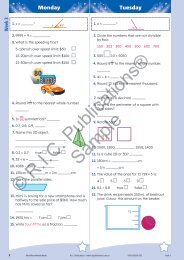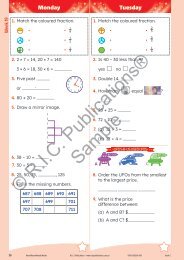RIC-20104_Australian_Curriculum_History_(Yr_2)_Respecting_the_past
You also want an ePaper? Increase the reach of your titles
YUMPU automatically turns print PDFs into web optimized ePapers that Google loves.
What is The Dreaming?<br />
The importance of an historical site of cultural importance or spiritual significance; for example, a community<br />
building, a landmark, a war memorial (ACHHK045)<br />
RESPECTING THE PAST<br />
Time line<br />
(Time line of some events in <strong>the</strong><br />
history of <strong>the</strong> Blue Mountains.)<br />
170 million years ago<br />
A plateau is created by a<br />
volcanic eruption. Over<br />
time, deep valleys and<br />
gorges were cut into it by<br />
<strong>the</strong> effects of rain, wind,<br />
heating and cooling to<br />
eventually form what is<br />
now known as <strong>the</strong> Blue<br />
Mountains<br />
Aboriginal <strong>Australian</strong>s fi rst to<br />
inhabit <strong>the</strong> Blue Mountains, date<br />
unknown (under 50 000 years<br />
ago)<br />
1788 Named ‘Carmar<strong>the</strong>n<br />
and Lansdowne Hills’ by<br />
Governor Arthur Phillip.<br />
Soon after, name changed<br />
to Blue Mountains<br />
because of <strong>the</strong> blue haze<br />
when viewed from a<br />
distance<br />
1813 First offi cial European<br />
crossing by explorers<br />
Blaxland, Lawson and<br />
Wentworth<br />
Resources<br />
• Photographs of <strong>the</strong> Three Sisters rock<br />
formation from resource books or <strong>the</strong><br />
internet.<br />
• Map of Australia and New South Wales.<br />
• The Aboriginal people of Australia by Anne<br />
Bartlett.<br />
Teacher information<br />
Elaboration<br />
Understanding <strong>the</strong> importance of Aboriginal and Torres Strait Islander Dreaming stories and <strong>the</strong><br />
connection to signifi cant sacred sites<br />
Key inquiry questions<br />
What aspects of <strong>the</strong> <strong>past</strong> can you see today? What do <strong>the</strong>y tell us?<br />
Historical skills<br />
• Distinguish between <strong>past</strong>, present and future (ACHHS048)<br />
• Explore a range of sources about <strong>the</strong> <strong>past</strong> (ACHHS050)<br />
• Identify and compare features of objects from <strong>the</strong> <strong>past</strong> and present (ACHHS051)<br />
• Explore a point of view (ACHHS052)<br />
Historical concepts<br />
• Continuity and change • Cause and effect • Perspectives • Signifi cance<br />
Background information<br />
• Aboriginal and Torres Strait Islander (ATSI) people have <strong>the</strong> longest continuous cultural history<br />
of any group on Earth, dating back 65 000 years. The Dreaming is <strong>the</strong> term Aboriginal people<br />
use to explain <strong>the</strong> creation and culture of <strong>the</strong> land and its people. (Depending where Torres<br />
Strait Islander people live, <strong>the</strong>y use terms like ‘Before Time’ or ‘Zogo Time’.) After <strong>the</strong> spirits of<br />
<strong>the</strong> ancestors created <strong>the</strong> natural environment, <strong>the</strong>y came to rest within features of <strong>the</strong> natural<br />
environment. These places are considered sacred sites in ATSI culture. Each site is associated<br />
with creation stories.<br />
• As ATSI people did not have a written language, <strong>the</strong>y orally passed on <strong>the</strong>ir knowledge and<br />
wisdom from one generation to <strong>the</strong> next. This was done through storytelling, song, poetry, drama<br />
and dance, as well as art. Each different ATSI group tells creation stories in its own special way,<br />
but <strong>the</strong> stories generally have similarities.<br />
Teaching notes<br />
• This unit will assist students in understanding why sites are signifi cant to Aboriginal people and<br />
<strong>the</strong> role Dreaming stories have for each site.<br />
©R.I.C. Publications<br />
Low Resolution Images<br />
Display Copy<br />
• Page 35 provides a simple explanation of what <strong>the</strong> Dreaming means to Aboriginal people.<br />
• Pages 36 and 37 include two versions of a Dreaming story about <strong>the</strong> Three Sisters rock<br />
formation in <strong>the</strong> Blue Mountains in New South Wales. Show students its location on a map. This<br />
site is signifi cant to Aboriginal <strong>Australian</strong>s and is also a very popular tourist landmark. The two<br />
versions of <strong>the</strong> story will enable students to explore, in a simple way, different perspectives of<br />
different Aboriginal groups. Page 35 can be completed in pairs, small groups or as a whole class.<br />
Keywords can be used instead of full sentence answers. Discuss <strong>the</strong> similarities and differences<br />
between <strong>the</strong> stories.<br />
Additional activities<br />
• A short video of a Dreaming story about <strong>the</strong> Three Sisters can be viewed at:<br />
<br />
• Read and discuss different versions of o<strong>the</strong>r Dreaming stories relating to signifi cant sites. A<br />
common Aboriginal <strong>Australian</strong> Dreaming story across many groups involves <strong>the</strong> Rainbow<br />
Serpent. Torres Strait Islander creation stories usually involve <strong>the</strong> Tagai, or warrior, and <strong>the</strong> sea<br />
and stars (as <strong>the</strong>y are seafaring people).<br />
<strong>Australian</strong> <strong>Curriculum</strong> <strong>History</strong>: The <strong>past</strong> in <strong>the</strong> present R.I.C. Publications ® www.ricpublications.com.au<br />
34


















